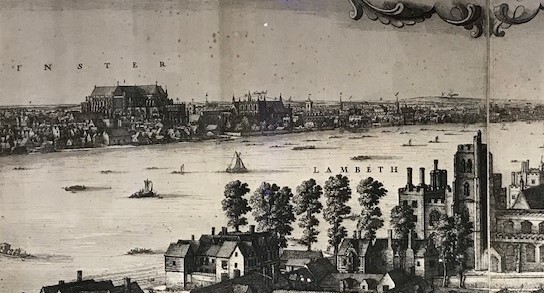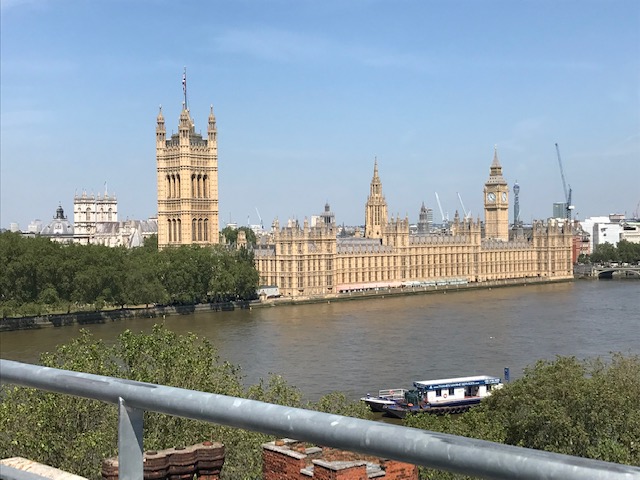We know rather more about the church of St. Mary the Virgin, Lambeth (aka St Mary-at-Lambeth) than is usual for Domesday churches. For most of them, the Domesday Book entry is the earliest record of their existence, and we have no idea when they were first built – eleventh century? tenth? ninth? – or by whom. But for St Mary-at-Lambeth we have a story.
In the middle decades of the eleventh century it seems that the manor of North Lambeth was held by Goda, Countess of Boulogne and sister to the English king Edward the Confessor. At this time, directly across the Thames on Thorney Island, Edward was busily building a new stone church in the fashionable Norman style, to serve the island’s Benedictine monastery. In doing so he was laying the foundations of a new royal zone in the west, a counter-balance to the largely self-governing city of London to the east. His new church was dedicated to St Peter, and came to be known as the West Minster, in contrast to St Paul’s, the East Minster, in the city.
It is tempting to see the founding of St Mary-at-Lambeth as a sisterly gesture of support by Countess Goda for her brother’s efforts. The site faced Westminster across the river. It was close to the location of the reputed ford, and later to the horse ferry, still remembered in Horseferry Road on the opposite bank, which perhaps succeeded the ford. So it is not entirely fanciful to suggest that the first St Mary’s was envisaged as a south-bank extension of Edward’s works. A century later, the Archbishop of Canterbury recognised the site’s convenience as a point of access to London’s centres of power when he acquired land right next door and on it built Lambeth Palace.
And yet, despite standing beside the Archbishop’s palace, St Mary’s ceased to function as a church half a century ago. It closed in 1972, and in 1979 was rescued by the Tradescant Trust, named for a family of pioneering seventeenth century gardeners, to embark on a new career as the Garden Museum. For those of us interested primarily in its character as a church building, this is a mixed blessing. On the one hand, its role as a museum has secured the building’s existence which might otherwise have been in doubt. On the other, the interior is now quite properly organised as a museum, and its original identity as a church is, if not lost, then certainly muted.
The oldest parts of the fabric date from the late fourteenth century, when Goda’s building was replaced. The fourteenth century church was altogether larger and more ambitious than its predecessor, its five-bay nave “nobly proportioned” according to Pevsner.
This was the period of mature Gothic, when much of the creativity of church architecture was focused on windows and light; improved skills in engineering and glass-making made possible ever-larger windows, whose stained glass lit interiors to stunning effect. In the late fourteenth century the daring window tracery of the ‘Decorated’ style was giving way to the even more radical designs of the ‘Perpendicular’. But in the case of St Mary’s, we cannot be sure what its fourteenth century windows looked like, because they were removed and replaced in the nineteenth century, when the architect Philip Hardwick put in new windows to his own design.
Hardwick’s restoration was not confined to the windows, a drastic re-build rather than a careful restoration. But one major medieval feature survives: the solid and impressive south-west tower.
It still stands, and can still be climbed, so long as you don’t suffer from claustrophobia.
From the top, you have access to some wonderful views along and across the River Thames.
Hardly surprising that this is where Wenceslas Hollar stood almost four hundred years ago: St Mary’s tower was one of the high points he used for a series of bird’s-eye panoramas of London from the 1640s to the 1660s. But Hollar was a master of imaginative deception; the detail below shows the church in the bottom right-hand corner with Lambeth Palace peeping out behind, as if the artist were looking down on his own vantage point. And its proximity to Westminster is clear, with the bulk of the Abbey – not yet marked by the two west towers which we know today – clearly visible across the Thames.
Hence, I suspect, the reason for building the first St Mary’s in the last years of Anglo-Saxon England.
SOURCES
Bridget Cherry & Nikolaus Pevsner, The Buildings of England: London 2: South, Penguin Books, London, 1994.
Survey of London, Volume 23, Lambeth: South Bank and Vauxhall, London County Council, 1951.






